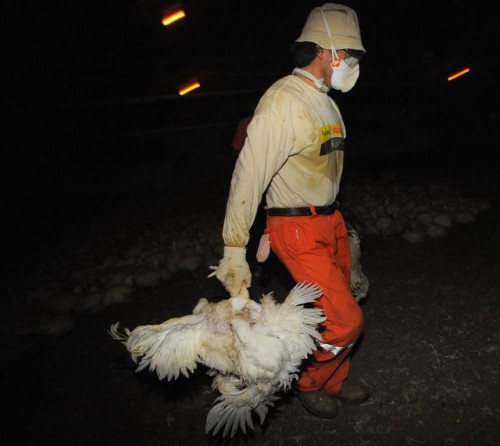These Disgusting Revelations About the UK Chicken Industry Will Confirm Your Worst Fears About Meat
A five-month undercover investigation by The Guardian, published this week, reveals some of the UK chicken industry’s darkest secrets.

The investigation focussed on meat processing plants that supply some of the UK’s largest supermarkets, including Tesco, M&S and Asda. It found that a shocking two-thirds of fresh retail chicken in the UK is contaminated with campylobacter, a potentially deadly cause of food poisoning. In the UK, approximately 280,000 people a year are thought to become ill from campylobacter (80 per cent of which comes from chicken).
Some of the images and video footage from the investigation – showing mountains of chicken guts piled on bloody factory floors, conveyor belts heaped up with faeces-coated feathers and filthy machinery – are certainly likely to put many people off eating meat.
But the investigation’s findings weren’t just disturbing from the point of view of hygiene. They also provide a chilling glimpse into how chickens are treated and killed before they end up as a pile of offal on a dirty factory floor. The following are some of the upsetting facts:
On the Farm
- On large-scale industrial farms, as many as 40,000 chickens at a time are raised in “crops”.
- The birds usually reach slaughter weight (around 1.8kg) in just 42 days.
- Farms cram as many animals as possible into vast, poorly lit sheds. The Guardian writes:
“To maximise return on capital invested in floor space, it is common practice to overstock sheds with chicks at the beginning of the cycle and then send in teams of catchers to thin out some of the birds so that the rest of the chickens have just enough room to meet regulations on stocking densities as they grow to full slaughter weight”.
- According to the reporters, this practice of chicken “thinning” leads to the spread of bacteria, because the frightened animals panic and defecate whenever workers enter the densely packed sheds.
The Journey to Death
- Chickens are packed into crates which are piled on top of one another in lorries and driven to the slaughterhouse. Faeces fall through the gaps in the crates onto the birds at the bottom.
- Transport is highly stressful for the animals, but it can last for hours. Sometimes they’re even left in the crates overnight.
At the Abattoir
On abattoir “production lines”, birds are shackled and hung upside down by their feet on a moving conveyor belt which carries them to their death and dismemberment.
- After they’ve been slaughtered, rubber fingers pull out their feathers and automated metal fists scoop out their guts before their body parts are packaged for the supermarket.
- Large abattoirs typically run lines at a rate of 185 to 195 birds a minute – killing nearly 12,000 animals an hour. Across Britain, a staggering 17 million chickens are slaughtered each week.
Chickens are sensitive animals with unique personalities. Like us, they dream, sunbathe, live in complex societies and make sacrifices to protect their children – that is, when they have the chance. On intensive farms, they never get the chance to express any of this natural behaviour. All they know is suffering and terror.
Please do your part to stop the suffering of these abused animals by never eating chicken. You could avoid a nasty case of food poisoning at the same time!
Our 30-day pledge is a great way to get started on a compassionate diet:
Image: Jo-Anne McArthur | We Animals



